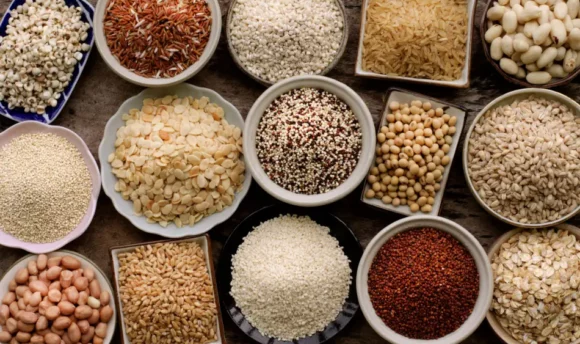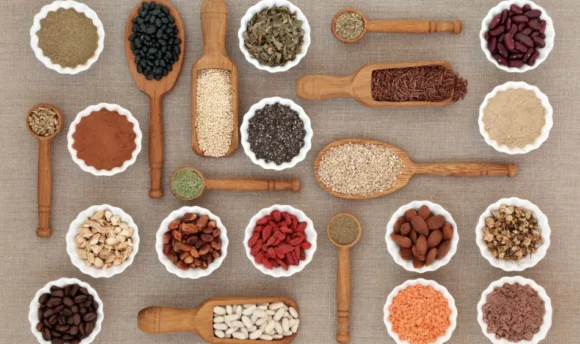Is Seitan Healthy? Nutrition, Calories, Ingredients

Are you looking for a protein source that is both high in protein, low in fat and calories, and rich in beneficial nutrients? Then, seitan may be just the food for you.
Does a high-protein, low-fat meatless product sound too good to be true? Maybe it is! Seitan is a versatile and tasty food product often used to make meat substitutes, such as meatless hot dogs or deli meat slices. Read on to find out more about this exciting protein!
Is Seitan Healthy?
Yes, seitan is a healthy vegan protein source that is very low in calories and fat. Seitan also provides vitamins and minerals, including iron, phosphorus, and selenium. However, consume seitan in moderation as it is slightly high in sodium.
What Is Seitan?
Also known as wheat meat, seitan is a plant-based meat substitute that resembles meat, unlike tofu and tempeh. It can be sliced, diced, cubed, and more; the opportunities are endless.
Similar to tofu, the seitan taste will resemble whatever you cook with it. It will quickly absorb any sauce or flavorings added to it.
You can purchase seitan ready-to-eat, heat it, and add it to your dishes, such as a sandwich, soups, stews, or stir-fries with soy sauce. Seitan is often found in the produce or deli section of the grocery store, or you can make homemade seitan.
Is Vital Wheat Gluten in Seitan Healthy?
Vital wheat gluten is the high protein component in wheat flour that is used to make seitan.
The wheat protein is rich in essential vitamins and minerals, specifically iron. In addition, vital wheat gluten has a small number of carbohydrates.
Overall, vital wheat gluten is healthy since it contains protein, vitamins, and minerals.
Health Benefits of Seitan
Seitan is plant-based meat and wheat protein that is packed full of nutrition and has many health benefits. Seitan is nutrient-dense, cholesterol-free, and appropriate for those with a soybean allergy.
According to Texas Health and Human Services, nutrient-dense foods have more nutrition per bite of the food. Conversely, calorie-dense foods have more calories than nutrition in each bite.
Nutrient-dense foods are healthier than calorie-dense foods. For example, seitan is considered very nutrient-dense since it is low in calories and high in protein, vitamins, and minerals.
Seitan is cholesterol-free compared to traditional protein sources, such as meat, poultry, fish, and eggs.
All of the cholesterol the body needs is made naturally in the liver; therefore, it is not a necessary component of a healthy diet.
Although the guideline previously recommended consuming no more than 200–300 milligrams of cholesterol daily, the 2020–2025 Dietary Guidelines for Americans now recommends consuming as little cholesterol as possible.
Finally, seitan, or wheat meat, is entirely wheat-based, primarily composed of wheat gluten. Since it is soy-free, eating seitan is an excellent alternative for those who have soybean allergies or are sensitive to soy.
What Are the Possible Side Effects of Seitan?
Seitan is overall very nutritious and safe. However, a few drawbacks of consuming seitan include moderately high sodium content, unsuitable for gluten intolerance or allergy, and low in fiber.
In a 100g serving of seitan, there are almost 300 milligrams of sodium or salt.
The University of California San Francisco states that a “high-sodium” food has 400 milligrams or more, and a “low-sodium” food has 140 milligrams or less. Therefore, seitan is considered a slightly high sodium food and should only be consumed in moderation.
Consuming excess sodium can increase the risk of heart disease, including high blood pressure, stroke, and heart attack.
Additionally, for those who have a gluten intolerance, gluten sensitivity, or celiac disease, seitan may cause symptoms of bloating, flatulence, or fatigue.
According to the Cleveland Clinic, celiac disease is an autoimmune disorder in which the body reacts to gluten as if it were a dangerous virus. This causes a severe amount of inflammation and damage to one’s digestive system.
A gluten allergy is when the immune system reacts to gluten, while gluten intolerance is gluten sensitivity.
If you have celiac disease, gluten allergy, or gluten intolerance, it is essential to stick with soy-based protein sources if you are vegetarian or vegan.
Finally, seitan has only 1.2 grams of dietary fiber in a 100g serving. According to the Mayo Clinic, fiber is needed for a healthy digestive system and can reduce constipation.
What Ingredients Does Seitan Contain?
Besides water, the main ingredient in seitan is vital wheat gluten from wheat flour. Gluten is the general name for the proteins in wheat.
According to the Celiac Disease Foundation, gluten helps foods keep their unique shape since it is similar to a glue that holds food together. The gluten in seitan comes from wheat, often found in bread, baked desserts, pasta noodles, and more.
Seitan also can contain legumes, such as beans and lentils. Beans and lentils significantly add to the protein composition of seitan and their savory taste.
Legumes are also rich in complex carbohydrates and fiber. Legumes have been linked with decreased risk of heart disease, cancer, digestive issues, obesity, and diabetes.
Lastly, seitan is flavored with spices such as garlic and onion.
Nutrition Facts
Seitan is a nutritious food containing protein, vitamins, minerals, and more.
Nutrition table (per 100g)
| Calories/Nutrient | Amount |
| Calories (kcal) | 107 |
| Net Carbs (g) | 9.52 |
| Fiber (g) | 1.2 |
| Sugar (g) | 1.19 |
| Fats (Total) | 0.77 |
| Protein (g) | 17.9 |
| Cholesterol (mg) | 0 |
High in vitamins and minerals
According to the United States Department of Agriculture food database (USDA), a serving of seitan is rich in phosphorus, iron, and selenium.
Iron is essential for those following a vegetarian or vegan diet since it primarily comes from poultry and red meat.
Iron supports healthy blood production and works to transport oxygen to cells all around the body through the blood.
High in protein
A serving of 100g of seitan contains a whopping 17.9g of protein.
According to the National Library of Medicine and the U.S. Department of Health and Human Services, protein is essential in cell repair and growth, especially in children and pregnant women.
Since seitan is entirely wheat and legume-based, along with some spices and flavoring, it is a complete protein appropriate for vegetarian and vegan diets. Legumes, such as beans and lentils, are full of essential amino acids making a complete protein.
Unfortunately, for those following vegetarian and vegan diets, getting adequate amounts of protein is often challenging, especially for those who are sensitive or allergic to soy.
Low in fats and calories
Seitan only has 107 calories per 100g serving. As mentioned previously, since it is very low in calories, seitan is nutrient-dense.
Consuming more nutrient-dense foods than calorie-dense or energy-dense contributes to a healthy and balanced diet.
Additionally, seitan has less than one gram of total fat in a 100g serving. Also, it has no saturated fat and trans fat.
Healthy fats, such as monounsaturated fat, help you feel full and satisfied with your meal.
To add healthy fat to your seitan, add olive oil, avocado, or another monounsaturated fat source.
Low in carbs
Protein sources, such as meat, poultry, fish, and eggs, are typically low in carbohydrates. However, seitan has about 9 grams of carbs per 100g serving.
Seitan – since it is wheat-based – contains carbohydrates. However, 100g of seitan is over a serving of seitan, so 9.52g is relatively low for the amount eaten.
For comparison, a slice of white sandwich bread has approximately 13g of carbohydrates.
While carbohydrates are essential to a healthy and balanced diet, consuming an excessive amount can lead to adverse health effects.
FAQs
Yes, seitan primarily contains gluten, red beans, lentils, sugar, and spices. It does not contain soy.
Soy-based meats can substitute seitan. If you have gluten intolerance, soy-based meat alternatives are better for you.
A Word From a Dietitian
Seitan is an excellent way for individuals to get their essential amino acids, making a complete protein. It is a vegetarian and vegan meat substitute. Additionally, seitan is low in calories and fat, making it a great addition to a healthy plate.
It contains essential vitamins and minerals, including phosphorus, iron, and selenium. Iron is especially necessary for vegetarians and vegans who do not consume any poultry, meat, or fish.
Seitan is versatile in its culinary uses, from atop salads, sandwiches, stir-fries, and more. Since purchased ready-to-eat from the grocery store, seitan is simple to prepare – just heat and then serve!
Conclusion
We hope that you found this article helpful in learning about seitan’s health benefits and risks.
Seitan is a healthy and versatile meat substitute. However, it is moderately high in sodium.
Therefore, seitan can be incorporated into a healthy vegetarian and vegan diet but should not be the only source of protein. Consume a wide variety of complete protein sources in a plant-based diet, including plant-based meat alternatives.

















































 Select your language:
Select your language: 








